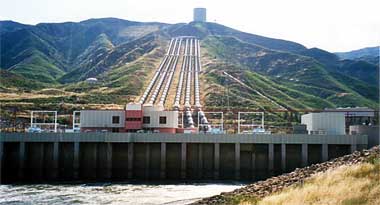
LADWP is proposing to spend $3 billion on a pumped storage facility at the Hoover Dam on the Colorado River. Yet, LADWP has not been using extensively its aging 1,247 MW Castaic pumped storage plant on the State Water Project in the pumping recovery mode. Instead, LADWP runs it more like a standard hydropower plant, and uses pumping to supplement and extend the peak power generation, rather than using it to store excess day time power. And the SWP’s 759 MW pumped storage plant at the Hyatt-Thermalito powerhouse at Lake Oroville has been not been used effectively for decades.
The more prudent course would seem to be to focus on refurbishing and updating existing facilities, with variable speed pumps for example, to deliver utility scale storage that can capture excess renewable energy generation nearer large load centers. The State Water Contractors should be incented to upgrade these facilities through contracts with the state’s electric utilities. Unfortunately, no direct market mechanism exists to provide a true value for these resources so long at the California Public Utilities Commission and the California Independent System Operator avoid developing full pricing. As it stands, the current pricing scheme socializes and subsidizes a number of electricity services such as transmission, unit commitment decisions, and reliability services.

It looks like the DWP has improved the operation of their assets a bit-
Table 2. SWP Power Generation and Usage
Year Power Generated (GWh/year) Power Used (GWh/year)
2006 7,515 9,109
2007 6,410 9,276
2008 4,100 5,701
2009 4,255 5,438
2010 4,368 7,184
2011 5,258 8,583
2012 4,810 7,404
2013 3,679 5,733
2014 1,438 2,787
2015 1,699 3,483
20163 3,348 6,217
By chance do you know what their target were for 2017 and this year?
Mark
LikeLike
This is for the entire SWP hydro system, and it’s driven by water deliveries. The drought from 2012-2016 decreased deliveries and generation. 2017 should have had a much higher generation amount due to be unusually wet.
LikeLike
Thanks! I forgot to take into account that the 83″ of rain at our place would have a rather large impact on the water conveyance system in the state. If memory serves me correctly Helms pumped storage is a bit more of a closed system as far as water goes. If that is true than how PG&E uses the asset(s)- three generators- is based on their power cost benefit analysis without a concern for open water systems issues. Do you think one could infer some factor for how much they are using the asset(s) by looking into how big their loss is any given month.
A couple of years ago I was tracking Ivanpah, my PV system and Diablo and Helms output per month. I never did much with the Diablo/Helms data. Can one infer much from the six months of data I saved from a couple years back?
LikeLike
The efficiency loss is about 30% at Helms. The overall gross energy capacity factor is 4% on average. So the month that shows a use of 101 GWH implies that Helms generated 235 GWH while using 336 GWH to pump.
LikeLike
Thanks for references- I wasn’t aware of this caveat!- “…full operation of THPP will
provide as much as 300,000 MWh annually and potentially restore SWP pump-back
operational flexibility.
LikeLike